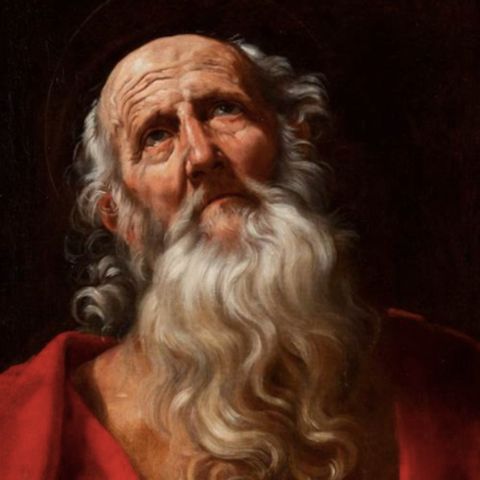September 30: Saint Jerome, Priest and Doctor

Download and listen anywhere
Download your favorite episodes and enjoy them, wherever you are! Sign up or log in now to access offline listening.
Description
September 30: Saint Jerome, Priest and Doctor c. 345–420 Memorial; Liturgical Color: White Patron Saint of archeologists, Biblical scholars, and librarians A prickly scholar translates the Bible into Latin forever...
show morec. 345–420
Memorial; Liturgical Color: White
Patron Saint of archeologists, Biblical scholars, and librarians
A prickly scholar translates the Bible into Latin forever and always
Today’s saint was living in Antioch in the 370s when he had a vision. Jerome was standing in the presence of the seated Christ, who asked him who he was. “I am a Christian,” Jerome responded. “LIAR!” Jesus yelled. “You are a Ciceronian, not a Christian, for where your treasure is, there also is your heart.” Jerome indeed loved Cicero and other Latin stylists. The fine prose in their works gave him the greatest pleasure. But Jerome had also been reared in a Christian home, been baptized as an adult in Rome, and had frequently descended into the darkened catacombs to pray at the tombs of the martyrs and saints. His double identity as a scholar of Latin and Greek rhetoric on the one hand, and as a committed Christian on the other hand, dueled within him. Jerome fervently loved God and the Catholic religion with all his soul, but it was a troubled soul. Jerome was full of spit and vinegar. He was a complex man and a complex saint.
Saint Jerome was born in an unknown year in a region northeast of Venice, Italy. His father sent him as a young man to Rome to perfect his education under a famous tutor. Jerome was a superb student and mastered Latin and Greek. At about the age of thirty, he decided to become a monk and traveled to the desert of Syria. For four years he lived a life of austerity, penance, and isolation. He fasted from the classics he loved so much and instead studied Hebrew from a Jewish convert. When he finally came out of the desert, he was ordained a priest in Antioch but never truly exercised any priestly ministry. He studied under the great Saint Gregory Nazianzen in Constantinople and began to publish some translations and biblical commentaries. Around 382 Jerome went to Rome with his bishop to serve as an interpreter and aide. Jerome so impressed Pope Saint Damasus that the Pope then invited the young Jerome to be his secretary.
At this point, in his forties and while living in Rome, Jerome began the monumental task of translating the entire Bible into Latin from original Greek and Hebrew texts. It would take him years. The existing Old Latin Bible was not cohesive but a jumble of texts stitched together under one cover. Various scholars had generated divergent translations for purely local use. So the Gospel of John in a Jerusalem-based manuscript differed from the same Gospel in a manuscript in Gaul. The one Church, spread throughout the known world, needed one Bible to match its broad scope and theological unity. Jerome was the man for the job. After just a few years in Rome, after the death of his patron Pope Damasus, and due to the enemies his blunt words and fiery temper always seemed to create, Saint Jerome left Rome for the Holy Land. He lived in a cave near Bethlehem and focused on translating. Some holy and pious women from Rome followed him there and formed a quasi-monastic community around him.
Jerome’s translation, known as the Vulgate, became the standard Latin version of the Bible over time, pushing the Old Latin version into oblivion. The Council of Trent formally stated that the Vulgate was the official Bible of the Catholic Church. So Catholicism has a “The Bible,” a claim which no other church can make. No “The Bible” ever floated down from heaven on a golden pillow. Except for Jerome’s, a “The Bible” doesn’t exist. There are thousands of ancient scraps of Scripture from hundreds of ancient texts from scores of libraries and monasteries in dozens of countries, but a publisher and its consultants ultimately choose which texts to include in any published Bible and which to exclude. Catholicism has no such flimsy process. Its sacred word is not dependent on scholarly fashion and whim. It has a baseline.
The Vulgate is like a dropped anchor resting on the ocean floor. It keeps the ship of the Church from drifting. Catholicism is a religion of the Word more than of the Book, but it has a definitive book, nonetheless. The fiery Saint Jerome died peacefully in 420, exhausted from his scholarly labors and life of penance. His remains can be found directly below the high altar of Saint Mary Major Basilica in Rome in a handsome porphyry sarcophagus.
Saint Jerome, you lived a life dedicated to studying the Word of God, to penance, and to prayer. You placed your knowledge and scholarly gifts at the service of the Church which used them wisely. Help all the faithful to serve the Church as much as the Church serves them.
Information
| Author | Fr. Michael Black |
| Organization | Michael Black |
| Website | - |
| Tags |
Copyright 2024 - Spreaker Inc. an iHeartMedia Company
